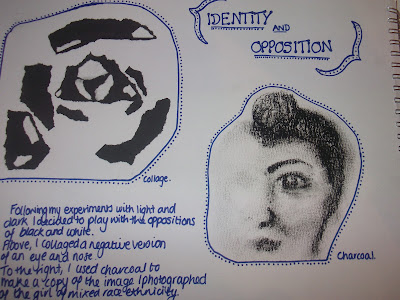Experiments in Instant Photo
For the documentary project, it is important to 'document' life as it can really be seen, even if that means showing something real from a specific or constructed view.
I have my own Fujifilm Instax camera and I felt that the medium of instant photography really epitomised the capturing of life in one opportunity.
I decided to capture people in an environment in which they don't know that they are being photographed.
This first experiment is a technical one - searching for settings on the camera that would create a well-shot photograph. Composition is also important here and I have tried to set up a shot with meaning beyond what you can see in the frame.
This was my first attempt to capture a moment of life and people in their own day. I used the 0.9-3m distance setting and the 'lighten' function on the camera. This made the branches in the foreground clear while the background is blurred. The exposure function seems to have had little effect due to the confusion of light areas and dark areas.
 The second photo was taken using the 3-infinity m function and the 'normal' exposure setting. All elements of the picture are clearer and the sunny areas are not too hot, however the foreground is still quite dark compared to the rest of the frame.
The second photo was taken using the 3-infinity m function and the 'normal' exposure setting. All elements of the picture are clearer and the sunny areas are not too hot, however the foreground is still quite dark compared to the rest of the frame.Composition: I used the branches and wall in the foreground to represent a surveillant mood. I like how you cannot see any faces - it disconnects the subjects from the viewer of the photograph. I think that the geometry of the photo is also interesting: the lines all lead to a perspective point on one side of the frame, and on the right of the frame all of the lines are horizontal.
Experiments in Landscape
People and Places. I decided to do two experiments with my instant camera. The first was to take in movement and personality within a particular landscape in which that environment is prevalent. The second was to capture an empty environment and experiment with man-made habitat and industrial shapes.
 I like the sense of being in this place that comes across in the photograph. There is a sense of life in motion and the circular lines on the floor draw the eye to the fountain in the centre and the children playing around it. There is a sense of off-screen activity with the person walking into the frame and this makes us aware of what is outside the frame as much as what is in it.
I like the sense of being in this place that comes across in the photograph. There is a sense of life in motion and the circular lines on the floor draw the eye to the fountain in the centre and the children playing around it. There is a sense of off-screen activity with the person walking into the frame and this makes us aware of what is outside the frame as much as what is in it. This photograph was taken from a moment of beauty and inspiration where the light blinded me and the camera shows more than I can see. I like the juxtaposing lines in the buildings and paving slabs and how the light hits the floor (despite the technical fault in the centre of the sun). The bird in the foreground makes the bottom half of the photo seem more three dimensional than the top half. This was the first time I had turned the camera sideways.
This photograph was taken from a moment of beauty and inspiration where the light blinded me and the camera shows more than I can see. I like the juxtaposing lines in the buildings and paving slabs and how the light hits the floor (despite the technical fault in the centre of the sun). The bird in the foreground makes the bottom half of the photo seem more three dimensional than the top half. This was the first time I had turned the camera sideways.In these photos I experimented with shadows in order to explore the theme of identity - a theme that comes hand in hand with portrait photography and video. I decided to explore the issue of race, inspired by Eve Arnold's art photography from the American Civil War. I used the brick wall as a background to represent the building blocks from which our ethnicity is created.
 Here I used a white man laughing into shadow to represent old fashioned ideas about race and ridicule.
Here I used a white man laughing into shadow to represent old fashioned ideas about race and ridicule. In the third photo I used a harsh shadow line in combination with a stand-offish pose to represent racial angst.
In the third photo I used a harsh shadow line in combination with a stand-offish pose to represent racial angst.Identity and Opposition
 Following my experiments with light and dark, I decided to play with the oppositions of black and white. I collaged a negative version of an eye and nose.
Following my experiments with light and dark, I decided to play with the oppositions of black and white. I collaged a negative version of an eye and nose. I used charcoal to make a copy of the image I photographed of the girl of mixed race ethnicity.






No comments:
Post a Comment